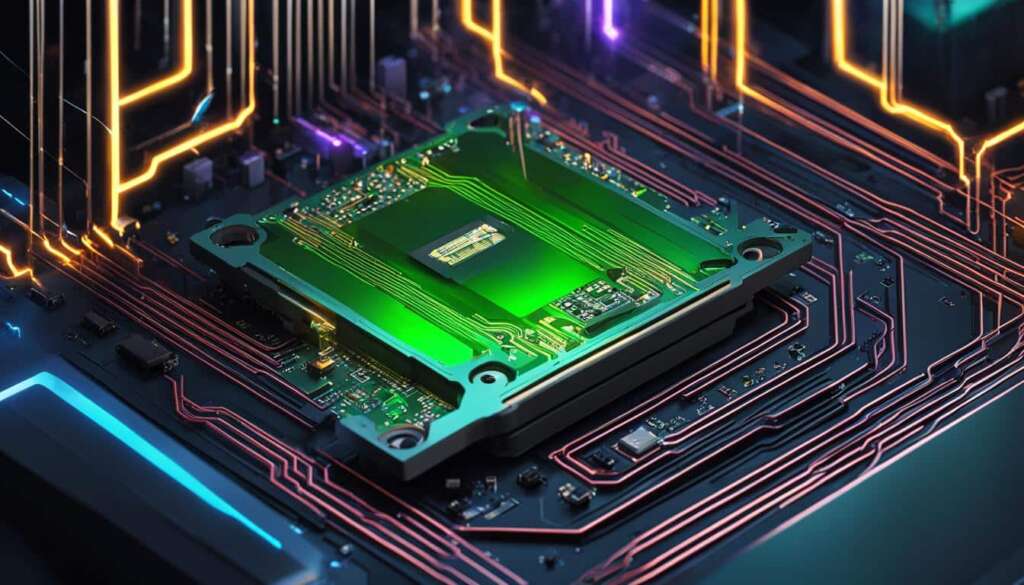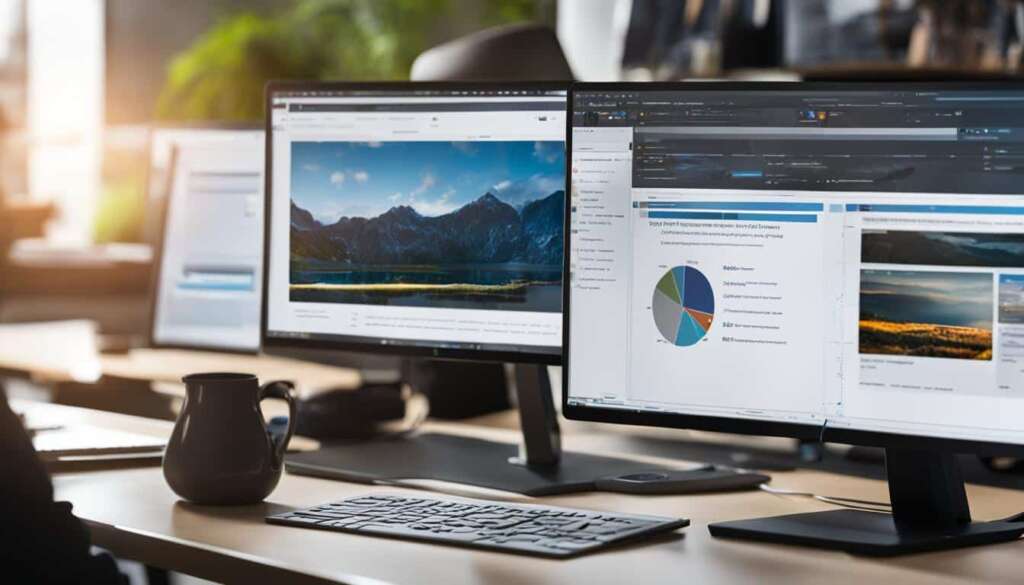Table of Contents
Are you a PC gamer looking to optimize your gaming performance? One of the key factors to consider is the frame rate, measured in frames per second (FPS), which determines how smoothly a game runs on your PC. A higher FPS translates to smoother on-screen motion and better gaming experience.
Monitoring the frame rate can help you diagnose performance issues and optimize your game settings. It also helps you assess your hardware’s gaming performance and determine if any upgrades are necessary. Furthermore, checking the FPS is crucial when choosing the right gaming monitor to enhance your gaming experience.
In this guide, we will explore various methods and tools that allow you to check and monitor your FPS on a PC. Whether you prefer using built-in FPS counters in platforms like Steam, Origin, Ubisoft Connect, and Xbox Game Bar or rely on third-party software like MSI Afterburner, we’ve got you covered. We will also delve into techniques to improve FPS on your PC, such as optimizing graphics settings, updating drivers, and closing background processes.
Join us in the upcoming sections as we dive deeper into understanding the importance of FPS in gaming and how it can dramatically impact your gaming performance and overall experience.
Ways to Check FPS on PC
Monitoring and maintaining a stable frame rate is crucial for optimal PC gaming performance. By checking and measuring FPS (frames per second), gamers can ensure smooth gameplay and identify any performance issues that may be affecting their experience. Thankfully, there are various ways to check FPS on a PC, both through built-in features in gaming platforms and third-party software.
Using Built-in FPS Counters
Several popular gaming platforms offer built-in FPS counters that can be easily enabled within their settings. Here are some options:
- Steam: Steam provides an in-game FPS counter that can be enabled in the settings. This allows players to constantly monitor their frame rate while playing.
- Origin, Ubisoft Connect, and Xbox Game Bar: These platforms also have built-in FPS counters, offering convenient solutions for tracking FPS without using additional software.
Third-Party Software for FPS Monitoring
In addition to built-in FPS counters, there are several third-party software options available for monitoring FPS and other performance stats:
MSI Afterburner: MSI Afterburner is a popular tool among PC gamers for monitoring FPS, as well as GPU temperature, clock speed, and more. It provides comprehensive performance statistics and allows for real-time monitoring and recording.
In-Game FPS Counters and Console Commands
Many games have their own FPS counters integrated into their settings menu, offering players an easy way to check and monitor their frame rate. Additionally, certain games, such as Sniper Elite 3, allow players to display FPS through console commands.
Xbox Game Bar Shortcut
An effortless way to access an FPS counter on Windows is by using the Xbox Game Bar shortcut (Windows key + G). This opens the Xbox Game Bar, which includes an FPS counter, allowing players to monitor their frame rate without interrupting their gameplay.
With these various methods available, PC gamers have plenty of options when it comes to checking and measuring FPS. Whether utilizing built-in features or third-party software, monitoring frame rate is essential for optimizing performance and ensuring a smooth and immersive gaming experience.
Tips to Improve FPS on PC
If you’re looking to optimize performance and increase FPS on your PC for an enhanced gaming experience, there are several strategies you can implement. By following these tips, you can ensure that your system is running at its best, providing smooth gameplay and maximizing your graphics settings.
1. Update Graphics Drivers
Upgrading your graphics drivers to the latest version can significantly improve performance and FPS in games. Manufacturers like NVIDIA and AMD regularly release driver updates that include optimizations for new games and bug fixes.
2. Optimize In-Game Graphics Settings
Tweaking the graphics settings within your games can have a significant impact on FPS. Lowering the resolution, reducing graphics quality, and disabling resource-intensive features like anti-aliasing can help increase FPS without sacrificing too much visual quality.
“By adjusting the graphics settings, you can strike a balance between performance and visual fidelity.”
3. Adjust Windows Power Options
Prevent performance throttling and improve FPS by adjusting the power options on your Windows PC. Make sure your power plan is set to “High Performance” to ensure your system utilizes its maximum potential for gaming.
4. Close Background Processes
Close unnecessary background processes to free up system resources and enhance gaming performance. Task Manager can be used to identify and close process-heavy applications, ensuring that your PC’s resources are dedicated to running your games smoothly.
5. Regularly Clean and Maintain Your PC
A well-maintained PC is essential for optimal performance. Regularly clean your PC, removing dust and ensuring proper airflow to prevent overheating. Additionally, regularly scan and remove malware that may be impacting your system’s efficiency and gaming performance.
6. Explore Advanced Methods
For those looking for further performance enhancements, there are advanced methods to consider. Overclocking your GPU and upgrading hardware components like the CPU or RAM can provide a noticeable boost in FPS. However, these methods require technical expertise and careful monitoring to avoid potential risks.
7. Monitor System Temperature
Monitoring and controlling system temperature is crucial for maintaining optimal performance. Excessive heat can lead to performance throttling and reduced FPS. Use software utilities or hardware monitoring tools to keep an eye on your system’s temperature and ensure it stays within safe limits.
8. Utilize Game Optimization Software
Game optimization software is available that automatically adjusts in-game settings to improve FPS. These programs analyze your system’s performance capabilities and make recommendations to optimize your gaming experience. However, be cautious when using third-party software and ensure you download from trusted sources.
9. Disabling V-Sync and Allocating Sufficient Resources
Disable V-Sync in your game settings to potentially increase FPS, as it can limit the frame rate synchronization. Additionally, make sure your system has sufficient resources allocated for gaming, such as RAM and VRAM, to prevent any bottlenecks that could negatively impact performance.
By implementing these tips, you can optimize your PC’s performance, increase FPS, and enjoy a smoother and more immersive gaming experience.
The Importance of FPS in Gaming
The Importance of FPS in Gaming
Having a smooth gameplay experience with responsive controls is crucial for an immersive gaming experience. This is where FPS, or frame rate, comes into play. Higher frame rates provide more fluid and responsive controls, resulting in a seamless gameplay experience.
But FPS doesn’t just impact controls; it also enhances the visual quality of games, making them more immersive. With higher FPS, you’ll enjoy sharper and more detailed graphics, vibrant colors, and smoother animations. It truly elevates the overall gaming experience and brings games to life.
Monitoring FPS is essential for assessing the performance of your hardware and optimizing game settings accordingly. By keeping an eye on your frame rate, you can identify any performance issues, adjust graphics settings, and ensure you’re getting the most out of your gaming rig.
When purchasing a new gaming monitor, FPS is a critical metric to consider. A monitor with a high refresh rate, such as 144Hz or 240Hz, can deliver smoother gameplay and more responsive controls. It’s important to match your monitor’s refresh rate with the capabilities of your hardware for an optimal gaming experience.
FAQ
How do I check FPS on my PC?
There are various tools and methods you can use to check the frame rate (FPS) on your PC. Built-in FPS counters are available in platforms like Steam, Origin, Ubisoft Connect, and Xbox Game Bar. Additionally, third-party software like MSI Afterburner can provide detailed performance statistics. Some games also have their own FPS counters in the settings menu, and certain console commands can display FPS as well.
Why is monitoring frame rate important in gaming?
Monitoring frame rate is important as it helps diagnose performance issues and optimize game settings. Higher FPS results in smoother on-screen motion and better gaming performance. By knowing the frame rate, you can determine if hardware upgrades are needed and ensure you choose the right monitor for an improved gaming experience.
How can I improve FPS on my PC?
There are several tips you can follow to improve FPS on your PC. First, ensure that your graphics drivers are up to date, as this can significantly improve performance. Optimizing in-game graphics settings, such as lowering the resolution or graphics quality, can also increase FPS. Adjusting Windows power options, closing unnecessary background processes, cleaning the PC, and removing malware can further enhance gaming performance. Advanced methods like overclocking the GPU and upgrading hardware components can provide a significant boost in FPS as well.
What is the importance of FPS in gaming?
FPS, or frame rate, is crucial in gaming for several reasons. Higher frame rates provide more fluid and responsive controls, resulting in smoother gameplay. It also enhances the visual quality of games and provides a more immersive gaming experience. Monitoring FPS allows you to assess the performance of your hardware and optimize game settings accordingly. When buying a new gaming monitor, FPS is an essential metric to consider. While the ideal frame rate is 60 FPS, higher frame rates can offer even better performance, although preferences may vary depending on the type of game.
How does FPS impact visual quality in games?
FPS and visual quality have a relationship where higher FPS generally improves visual quality. Higher frame rates result in smoother on-screen motion and reduce screen tearing. While lowering graphics settings and resolution can improve FPS, it’s important to find a balance to avoid sacrificing too much visual quality. Experimenting with different settings can help you achieve optimal gaming performance while maintaining satisfactory visuals.







